The Light and Spirit of Korea’s Traditional Buddhist Culture, Captivating New York City
Article by. Suh Hyon-wook Photo by. Ha Ji-kwon

New York City, the heartbeat of America, is captivated by the spirit and light of Korea’s traditional Buddhist culture. Korea’s traditional Buddhist culture—including food, clothing, shelter, Buddhist practice, rituals, and art—is an accumulation of historical, cultural, religious, and regional traditions and heritage, as well as the sum total of the life and spirit of Korean Buddhists. “Templestay” and “temple food”—whose influence was expanding both before and after the 2002 Korea-Japan World Cup—have become “hot items” that allow people to experience the essence of Korean traditional Buddhist culture in body and mind. These hot items are now available in Manhattan, captivating New Yorkers.
Templestay and other programs have been promoted at previous events in New York, but this year’s event was even more special. Hosted by Jinwoo Seunim, the President of the Jogye Order, this year’s event created even more buzz, and hundreds of well-known figures working in the cultural, tourist, diplomatic, and religious sectors of New York had the opportunity to taste temple food (vegan) prepared by the Cultural Corps of Korean Buddhism (hereafter “the Corps”) as the main menu for the banquet.
From October 5 to 13, the Corps promoted Templestay and temple food in Manhattan as part of the “2024 Korea-US Traditional Buddhist Cultural Exchange” project.
The Corps opened the “2024 Korean Festival Promotion Booth” on 5th Avenue and 32nd Street in New York City on October 5. Set up in New York City’s Koreatown, the booth was bustling with locals and Korean Americans all day long.
The Korean Festival Promotion Booth informed visitors about Korean traditional culture in the middle of Koreatown, the center of the Korean community in New York, raising the status and pride of Koreans everywhere. It also drew attention by introducing Korean Buddhist culture at one of New York’s well-known cultural festivals. It also promoted Korea’s annual Yeondeunghoe (Lantern Lighting
Festival), and provided a variety of experiences to participants, including making lanterns and prayer beads. Approximately 1,700 promotional materials were distributed about “Korea-US Buddhist Cultural Exchange,” Templestay and temple food. Approximately 250 locals packed the promotion booth to participate in making prayer beads, a program provided as a Templestay cultural experience.
The Corps also presented hundreds of souvenirs to New Yorkers who visited the booth, including handkerchiefs decorated with the lattice door designs seen at traditional temples, memo pads made of Korean traditional paper, ballpoint pens, and cell phone grips, all of which were received enthusiastically.
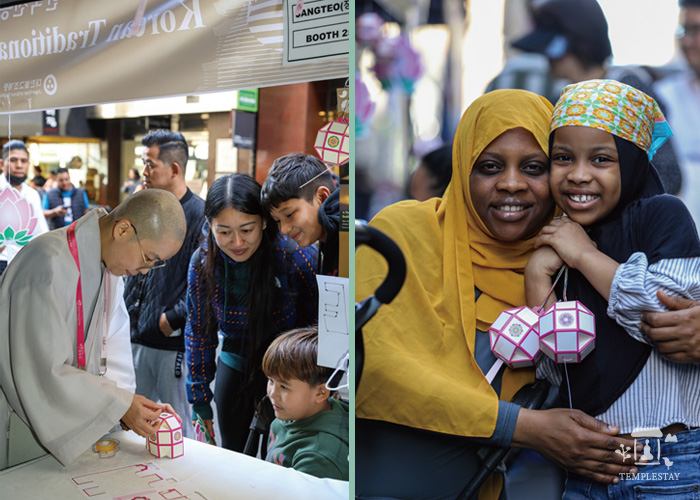
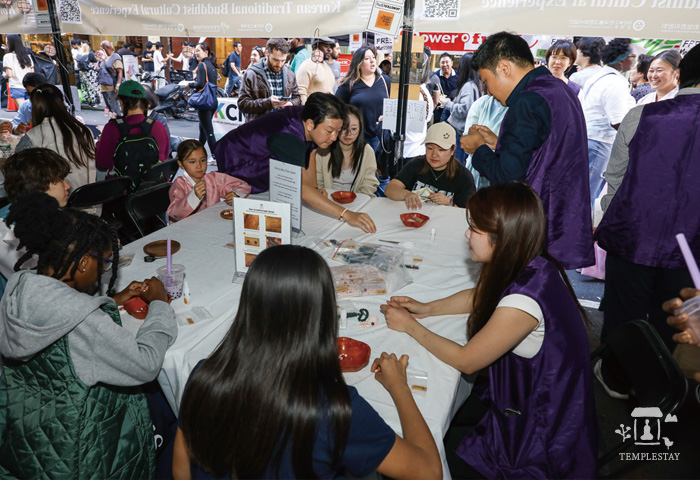
Following their participation in the Korean Festival in New York’s Koreatown, the Corps filled the newly opened Korean Cultural Center New York (hereafter “KCCNY”) with the beauty of Korean mountain temples and images of Korean Buddhism.
From October 7 to 13, the Corps filled the lobby and the drawing room on the 4th floor of the KCCNY with vivid images of the Korean Buddhist community. The Photo and Imaging Exhibition titled “Capturing 1,000 Years” artistically combined 20 real photos on display and 70 photos transformed into various video images, blending them with traditional lantern displays. The 1st floor courtyard of the KCCNY was transformed into a “photo zone” for visitors, increasing the number of participants.
The Photo and Imaging Exhibition depicted the theme of “morning at a mountain temple illuminated with light.” Images included the lotus blossom pattern from Janggyeonggak Hall at Haeinsa Temple, flying celestials from the main altar of Baekheungam Hermitage looking as if they would fly away at any moment, and the canopy from Ssanggyesa Temple in Nonsan with gorgeous carvings of birds in flight. All together they seemed to depict a heavenly world manifesting in reality.
The video also showed various scenes of practitioners paying homage to the buddhas and bodhisattvas while diligently immersed in practice. There were also rare photos of monastic residents digging up potatoes as part of their communal work at Bongamsa Temple, a temple which opens its doors to the public only once a year. Tongdosa Temple’s baru gongyang (formal monastic meal) and Hwaeomsa Temple’s meditation retreat (angeo) were also featured in photos to show the living present of the Korean Buddhist community.
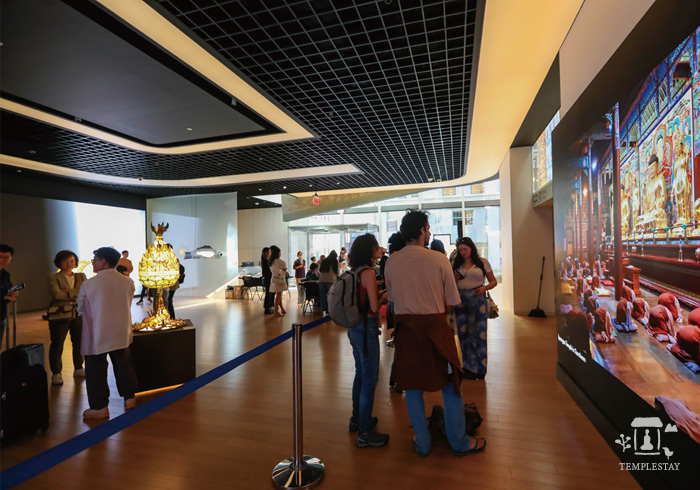
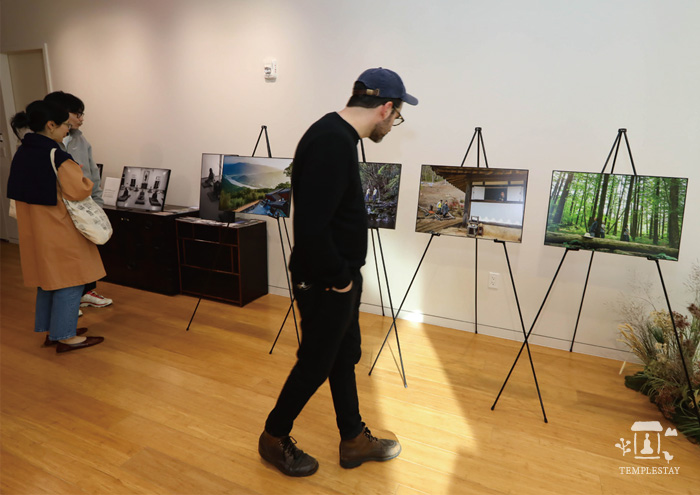
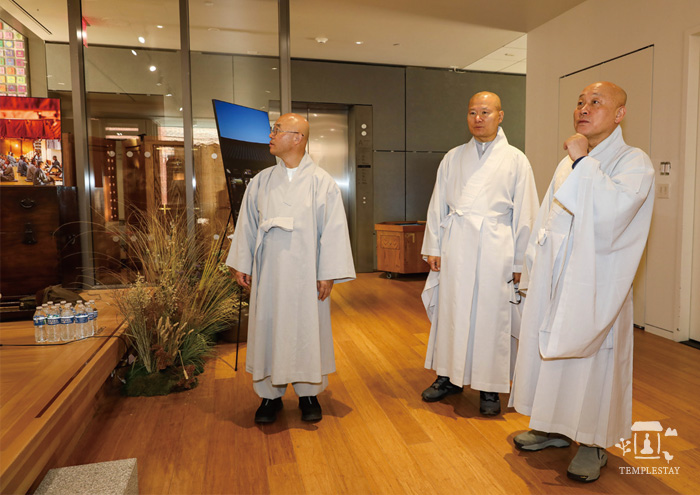
The KCCNY provided the space for an exhibition hall and an experience center.
From October 8 to 12, an experience center was set up where anyone could participate. New Yorkers made prayer beads to wear on their wrists, printed passages from the Heart Sutra using wooden printing blocks, and copied a sutra.
Participants drew traditional Korean patterns on fans and coasters and colored them with the five cardinal colors, which allowed them to connect with Korean Buddhism through physical activities. Over 500 locals participated in the “Korean Buddhist Traditional Culture Experience” program alone. A program to converse with a monk over tea—a popular Templestay activity—was held in Maru Hall on the 4th floor of KCCNY. Seonghyang and Seongnim Seunims from Wonjeoksa Temple in New Jersey had tea with participants who had made reservations and shared meaningful stories about Korean Buddhism and culture.
The “Korean Temple Food Cooking Experience” program was also popular. Under the guidance of temple food expert Jeong Kwan Seunim, participants made braised shiitake mushrooms with grain syrup, seasoned dried persimmons, fresh kimchi in tofu sauce, and rice wrapped in lotus leaf. Through these experiences participants gained a better understanding of temple food and the philosophy behind it.
On October 11, an invitation-only VIP banquet was held at Gotham Hall, a landmark building on Broadway in New York City, co-hosted by the Consulate General of the Republic of Korea in New York, with the theme of “Peace of Mind, Peace of the World.” Gotham Hall is also a popular concert venue for performers like Elton John.
The temple food served was made with seasonal ingredients flown in from Korea and consisted of appetizers, main dishes, and desserts. Appetizers included drinks and snacks. Drinks were made from extracts of omija (schisandra), bokbunja (Korean black raspberries), and plums mixed with carbonated water. Snacks included bugak, which is made by coating seaweed, potatoes, and lotus roots with glutinous rice paste, after which they are dried slightly and deep-fried. Additional appetizers included fried ginseng, braised shiitake mushrooms with grain syrup, and pickled cherry tomatoes. Main dishes included rice with glutinous millet, black trumpet mushroom soup, napa cabbage kimchi, seasoned dried persimmons, grilled burdock with pine nuts, pickled plums, and seasoned dried aster leaves. Desserts consisted of pine pollen dasik (a tea confection), fig jeonggwa, balloon flower root pyeongang, and tea from Baekyangsa Temple, capturing the mouths and hearts of about 250 locals.
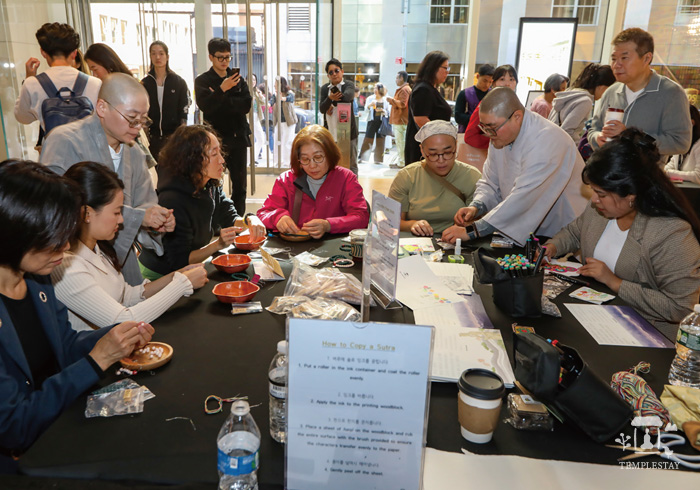
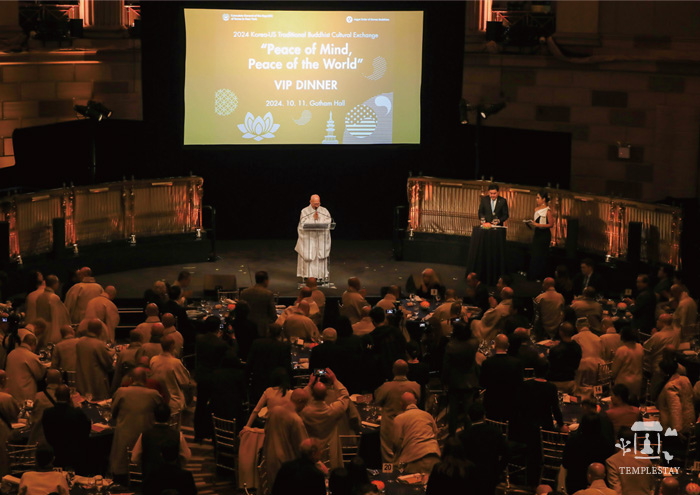
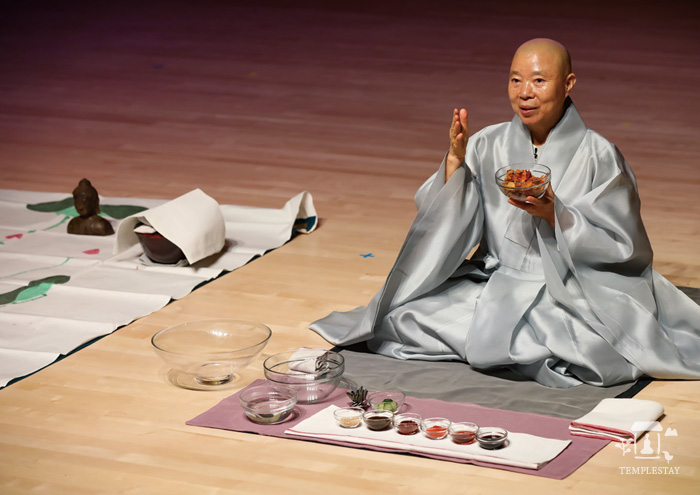
On the afternoon of October 12, a thin gray cushion was placed in a corner of the stage in the newly renovated KCCNY basement performance hall. On a white cloth in front of the cushion were glass bowls containing seven or eight food ingredients that would be used to make temple food. Jeong Kwan Seunim, a nun and temple food expert from Cheonjinam Hermitage of Baekyangsa Temple in Jangseong, Jeollanam-do, quietly opened the door, entered the stage, and sat down without making a sound. Hundreds of New Yorkers were watching.
She spoke to about 200 New Yorkers about the importance of the natural flavors of seasonal ingredients, and how the mindset of the chef must focus on the ingredients, the season, the time of day, the person who will eat the food, and how the food we eat can change our bodies and minds. This demonstration provided her audience—modern people too busy with material pursuits and satisfying sensual desires—with much to think about and a chance to reflect on their own lives.
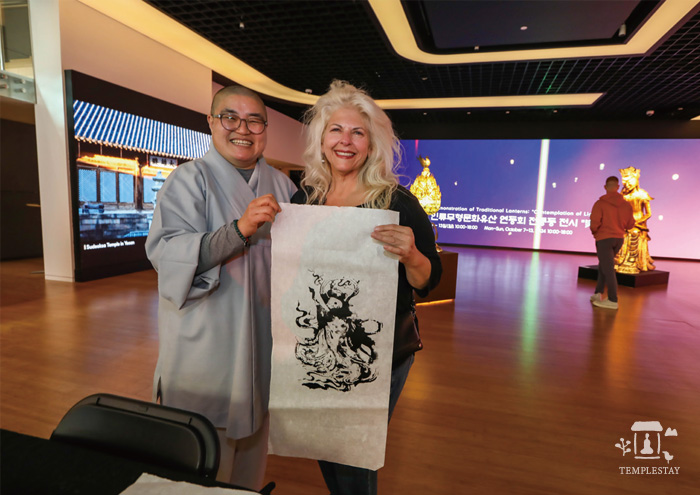
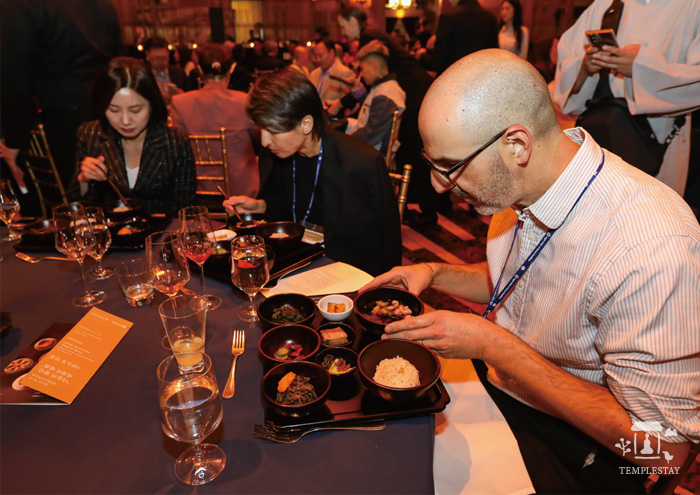
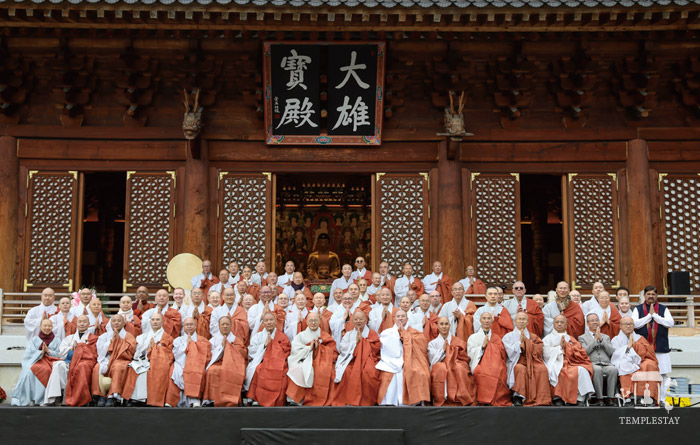
On October 12, the Jogye Order monastics group BTENS (Buddha Ten Sunims) performed in the KCCNY basement performance hall. Other performances included: Ven. Gogeum’s dharma drum, Ven. Giwon’s flute, Ven. Doguk’s Taekwondo, Ven. Beomjun’s vocals, Ven. Seowon’s dance protocol, and Ven. Jian’s gayageum (12-string Korean zither). These were sometimes performed as solo acts and sometimes as a joint performance. Ahn Chi-wook and Choe Do-seol—both trained at Golgulsa Temple, the headquarters of Seonmudo (a Korean martial arts based on Seon Buddhism)—demonstrated Seonmudo, and dancer Kim Su-yeon introduced Korean traditional dance accompanied by a Jindo drum performance. Vocalist Lee Su-wan from the traditional Korean music creative band BOB captivated the locals with folk songs and original traditional Korean music. The performance was packed with both people who held advance reservations and onsite visitors. The performers, including BTENS, have also performed at other major events such as the VIP banquet at Gotham Hall, the visit to comfort veterans of the Korean War, a talk on meditation with Ven. Jinwoo and Jon Kabat-Zinn, and the 50th anniversary ceremony of Wongaksa Temple, thereby playing a significant role in spreading Korean Buddhist culture.
The event concluded by celebrating the 50th anniversary of the founding of Wongaksa Temple in New York, an overseas special religious district of the Jogye Order. In his speech President Jinwoo Seunim said that he hopes to inform the world of the value of Korean Buddhism and move the world closer to the path of healing and peace. He also expressed his hope that Wongaksa Temple will continue to serve as a spiritual base in the United States for the globalization of Seon meditation.
The Corps and the Yeondeunghoe Association work together to provide more experiential opportunities for Templestays, temple food promotion, and traditional lantern making to Korean-American Buddhists and locals at Wongaksa Temple New York. A program to make soybean powder tea confections also attracted attention as it offered a unique experience rarely available in New York.





